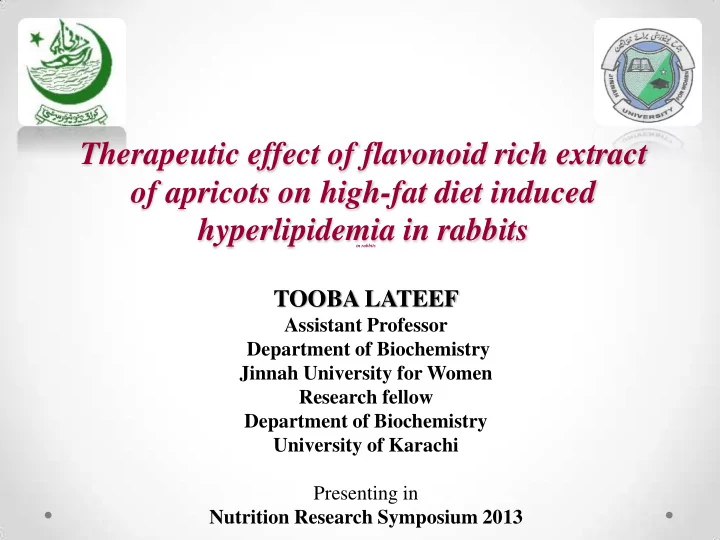

Therapeutic effect of flavonoid rich extract of apricots on high-fat diet induced hyperlipidemia in rabbits in rabbits TOOBA LATEEF Assistant Professor Department of Biochemistry Jinnah University for Women Research fellow Department of Biochemistry University of Karachi Presenting in Nutrition Research Symposium 2013
AIM OF THE STUDY To determine the antihyperlipidemic effect of flavonoid rich extract (FREt) of Prunus armeniaca (Apricots) in high-fat diet (HFD) induced hyperlipidemia in rabbits by determining the lipid profile including: total cholesterol (TC) triglycerides (TG) low density lipoprotein (LDL-c) high density lipoprotein (HDL-c) antiatherogenic index (AAI)
Hyperlipidemia , A Risk factor for Coronary Artery Disease! Health organization reports that high blood cholesterol contributes to approximately 56% cases of coronary artery disease worldwide and causes about 4.4 million deaths each year Hyperlipidemia, along with decrease in high-density lipoprotein (HDL-c) is the predictor of coronary artery disease (CAD) and an important risk factor in initiation and progression of atherosclerosis (Makwana et al., 2012) Several factors, such as diet high in saturated fats and cholesterol, age, family history, hypertension and life style play a significant role in the onset of CAD (Dhulasavant et al., 2010)
Therefore, prime consideration in the therapy for hyperlipidemia and arteriosclerosis is to attenuate the elevated blood lipid levels To reduce the risk of CAD researchers are focusing mainly on the treatment of hyperlipidemia (Balamurugan & Shantha, 2010) Treatments include; Diet and life style changes are the first step in treating hyperlipidemia (Lin et al., 2005) The known lipid lowering drugs, such as fibrates, statins and bile acid sequestrants have many side effects Therefore use of natural agents / herbal medicines, due to their minimal side effects and cost effectiveness is increasing day by day all over the world (Sowmya & Ananthi, 2011)
Prunus armeniaca Common name: Apricot Family: Rosaceae Origin: grows over the five continents of the World Rich in minerals, vitamins and a range of bioactive constituents (Jannatezadeh A et al, 2008) Also have hepatoprotective effect (Yurk & Celik, 2011) Beneficial effects on myocardial ischemia-reperfusion injuries (Parlakpinar et al, 2009) Protective effect on intestinal oxidative damages (Vardi et al, 2008) Currently its flavonoid extract was investigated for antihyperlipidemic potential in improving CAD in high-fat diet induced hyperlipidemia in rabbits
METHODOLOGY Preparation of flavonoid rich extract of Apricots; Fruits of P. armeniaca were purchased and grinded to fine powder 10 gms grinded Filtered and evaporated into powder, repeatedly dryness over water bath extracted with 100 ml 80% aqueous methanol Brown residue obtained referred as Flavonoid Rich Extract (FREt) (Bohm & Kocipai- Abyazan method, 1994)
Animals grouping; Rabbits (0.5 – 1.5 kg) Control (D.W 1 ml/kg) High Fat Diet (HFD) (orally per kg body weight HFD Control (D.W 1 ml/kg) HFD Test HFD Positive Control (Simvastatin 20 mg/kg) FREt (200 mg/kg)
Biochemical Parameters; TC, TG and HDL-c were determined by commercially available kits (Randox, UK) LDL-c and AAI were calculated by formulae; LDL-c (mg/dl) = TC – TG/5 – HDL-c AAI (%) = [HDL-c / TC – HDL-c] x 100 (Vazquez-Freire MJ, et al., 1996) Statistical Analysis; Results expressed as mean ± SD (Standard deviation). Data analyzed by one way ANOVA followed by LSD (least significant difference) test (SPSS, version 17.0). Differences considered significant with p< 0.05
RESULTS Effect of FREt on lipid profile: 250 TC TG 200 Lipid profile (mg/dl) * * HDL-c 150 LDL-c * 100 * 50 0 Control HFD Control HFD Pos Control FREt 200 mg/kg Groups Data: mean ± SD (n=6), * = statistically significant ( p< 0.05) when compared with HFD control
Effect of FREt on antiatherogenic index (AAI): 200 * 180 Antiatherogenic index (%) 160 140 120 100 80 60 40 20 0 Control HFD Control HFD Pos Control FREt 200 mg/kg Groups Data: mean ± SD (n=6), * = statistically significant ( p< 0.05) when compared with HFD control
DISCUSSION According to the result dose of FREt @ 200 showed a significant decrease in serum TC, TG and LDL-c levels and increase in HDL-c level The underlying mechanism of FREt in decreasing cholesterol may be by inhibiting the activity of rate-limiting enzyme of cholesterol metabolism i.e., HMG-CoA reductase (Ahmed, 2011) or by enhancing entero-hepatic circulation of cholesterol (Bahramika et al., 2008) Whereas decrease in TG may be by increasing activity of lipase that hydrolyzes TG under normal conditions or increase excretion of TG via feces (Sukla et al., 2004)
Increase in HDL-c has major role in athero-protective reverse cholesterol transport process involving HDL-c mediated efflux of cholesterol from peripheral tissues to the liver for excretion (Chapman et al., 2010) On the other hand, increase in LDL-c transports cholesterol to peripheral tissues or arteries forming atherosclerotic plug (Qureshi SA et al., 2010) In the present study increase in HDL-c and decrease in LDL-c was observed in test rabbits indicating that apricot FREt has antiatherogenic effect which is confirmed by calculating AAI FREt showed pronounced increase in AAI indicating its cardio-protective effect.
CONCLUSION FREt of P. armeniaca is a potent antihyperlipidemic and antioxidative agent Due to significant effect on lipid profile further research will help in finding most potent dose of P. armeniaca as antiatherogenic agent in humans and its most possible mechanism of action in lowering of blood lipids.
ACKNOWLEDGEMENT Dr. Shamim A. Qureshi (Research Supervisor) Assistant Professor, Department of Biochemistry University of Karachi, Pakistan
Recommend
More recommend